I first read Gagnon’s treatise shortly after its 2001 release, and I read it again a few weeks ago in preparation for leading a workshop at the recent Lutherans Concerned Convention. He is an accomplished exegete, and his historical-critical Biblical research is solid; however, his conclusions are suspect. Even as he surrenders the gay-bashing “clobber passages” to contemporary scholarship, he employs a “yes, but” reasoning that reclaims them again. And, as the darling theologian of the sola scriptura, word alone, “the Bible trumps science, reason, and experience” crowd, there is great irony in that his own thesis is based on his view of natural law and questionable science.
Category Archives: Books
Book Review: The Bible and Homosexual Practice by Robert Gagnon
Of human bondage
What motivates us as human beings? Why do we do what we do?
I am of the flesh, sold into slavery under sin. I do not understand my own actions. For I do not do what I want, but I do the very thing I hate. I see in my members another law at war with the law of my mind, making me captive to the law of sin that dwells in my members.
Wretched man that I am! Who will rescue me from this body of death?
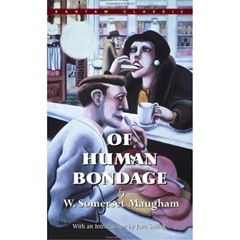 These words of Paul the apostle from the 7th chapter of his letter to the Romans serve as the epigraph to my novel and the source of the title, A Wretched Man, a novel of Paul the apostle. As these verses from Paul suggest, we have long wrestled with the problem of the human will. The wonderings of philosophers such as Schopenhauer & Nietzsche; psychoanalysts such as Freud & Jung; and literary figures such as Somerset Maugham & Thomas Mann suggest it’s complicated and self-awareness is difficult.
These words of Paul the apostle from the 7th chapter of his letter to the Romans serve as the epigraph to my novel and the source of the title, A Wretched Man, a novel of Paul the apostle. As these verses from Paul suggest, we have long wrestled with the problem of the human will. The wonderings of philosophers such as Schopenhauer & Nietzsche; psychoanalysts such as Freud & Jung; and literary figures such as Somerset Maugham & Thomas Mann suggest it’s complicated and self-awareness is difficult.
What about homophobia? What is the source of this phenomenon? Let’s start with a definition–this one is Merriam-Webster’s online version:
irrational fear of, aversion to, or discrimination against homosexuality or homosexuals
and Wikipedia’s description:
Homophobia is a range of negative attitudes and feelings towards homosexuality and people identified or perceived as being homosexual. Definitions refer variably to antipathy, contempt, prejudice, aversion, and irrational fear. Homophobia is observable in critical and hostile behavior such as discrimination and violence on the basis of a perceived non-heterosexual orientation. In a 1998 address, author, activist, and civil rights leader Coretta Scott King stated that “Homophobia is like racism and anti-Semitism and other forms of bigotry in that it seeks to dehumanize a large group of people, to deny their humanity, their dignity and personhood.”
Let’s take it a step further; what is “internalized homophobia”? Here’s the opening paragraph from a UC-Davis Psychology Department study:
Among lesbians, gay men, and bisexuals, internalized sexual stigma (also called internalized homophobia) refers to the personal acceptance and endorsement of sexual stigma as part of the individual’s value system and self-concept. It is the counterpart to sexual prejudice among heterosexuals.
In other words, it is gay folks accepting negative societal, cultural, or religious stigma and applying such negative values toward oneself. Self-condemnation. Self-doubt and low self esteem en extremis. It doesn’t take deep psychological insight to recognize that internalized homophobia is not healthy. High incidence of suicide. Drug and alcohol abuse. Inability to have meaningful relationships.
And sometimes, the internalized homophobia results in outrageous behavior toward other gays. An extreme example is Andrew Cunanan, the murderer of Gianni Versace; political examples include US Senator Larry Craig & California State Senator Ray Ashburn; and religious examples include Ted Haggard, “rentboy” William Rekers, and now Minnesota pastor and outspoken opponent of the ELCA gay friendly policies, Pastor Tom Brock of Hope Lutheran Church of Minneapolis (Hope Church is not ELCA but AFLC—Association of Free Lutheran Churches–a small and conservative Lutheran denomination).
The “outing” of Pastor Brock was a journalistic abomination for which there is no excuse, and the offending magazine has received appropriate condemnation. Yet, the exposure of Pastor Brock raises the question of other outspoken anti-gay religious leaders. Let me be perfectly clear, I make no suggestion that this is the sole or even the primary motivation for those religious leaders in various denominations that oppose gay inclusive policies. Yet, one wonders whether Pastor Brock is merely an isolated and atypical example or merely the tip of the iceberg. What is it about human sexuality that makes some squirm? How often does sexual angst undergird homophobia?
Whatever the motivation, religious leaders who bash gay folks over the head with their Bibles need to seriously question themselves—are they really offering a solution to gay suicide, gay drug and alcohol abuse, and gay casual relationships or are they part of the problem? Are they advancing the kingdom of God or stalling it? Are they truly seeking God’s will or merely proof texting the Bible to justify their own biases, prejudices and even their own homophobia?
Don’t, please don’t, respond with the horrific notion that you hate the sin but love the sinner, at worst a self-justifying excuse for murky motivations behind hurtful behavior and at best a misunderstanding of the reality of self-loathing that may be triggured by such seemingly benign comments.
Author appearances and advocacy
Regular followers of this blog know that I haven’t posted much lately, and that’s because I have been on the road promoting my novel, A Wretched Man. Most recently, I spent four days with the Wisconsin Annual Conference of the United Methodists (UMC) in La Crosse. I managed to sell a goodly number of books and network with numerous congregations and organizations that may use my book for an adult forum or book club discussion. The study guide that I prepared as a pdf document proved to be quite popular.
The trip to La Crosse had an unintended benefit: my exhibitor’s booth was placed next to Kairos CoMotion, an LGBT advocacy group within the Wisconsin UMC, and I had plenty of time to visit with Jim and Steve, a gay couple who have been together for many years and who were married in Toronto four years ago. Steve has long been an LGBT leader and spokesman within the Wisconsin UMC following his rejection for admission to a UMC seminary because he was gay. At the conclusion of the convention, I accompanied Jim and Steve to a meeting and communion service for the Kairos CoMotion supporters. I hope to post more about this group and the status of LGBT issues within the Wisconsin UMC later.
Switching from past book-related appearances to future ones, I note that in yesterday’s Minneapolis Star Tribune newspaper, I was lumped together with a couple of heavy hitters of progressive Catholicism under the header “Controversial Roman Catholic speakers are coming to Twin Cities.”
First on the scene is author Obie Holmen, who will be reading from his new book, “A Wretched Man,” Thursday at the House of the Beloved Disciple, 4001 38th Av. S., Minneapolis. The reading will be preceded by a 7 p.m. “mass of celebration for our LGBT brothers and sisters.”
I must smile at the article headline since I am not Roman Catholic nor do I think my support for the majority position of the ELCA on this blog qualifies me as “controversial”. But any press is good press, as they say, and to be linked with luminaries of Roman Catholic progressive thought such as British theologian James Alison and feminist theologian Rosemary Radford Ruether is flattering.
Early in July, the Presbyterian Church USA (PCUSA) will hold its national, General Assembly in Minneapolis. Cokesbury functions as the official booksellers for the Presbyterians, and their bookstore will offer my book for sale during the weeklong Presbyterian assembly that promises up to 8,000 attendees. On Monday, July 5th, at 2:30 pm, I will be present in the Cokesbury bookstore at the assembly to autograph copies of the novel.
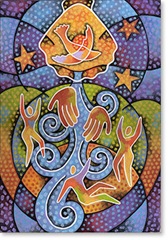 Finally, Lutherans Concerned North America (the ELCA gay advocacy group) will hold its biennial convention in Minneapolis beginning July 7th. The theme of the gathering will be Let Justice Roll Down Like Waters. On Saturday morning, July 10th at 8:30 am, I will present a workshop entitled “Paul the Apostle–History’s Greatest Homophobe?” The LCNA convention will close with a celebration dinner back at the Minneapolis Convention Center (after the PCUSA clears out) to remember and relive the historic vote in that venue last August.
Finally, Lutherans Concerned North America (the ELCA gay advocacy group) will hold its biennial convention in Minneapolis beginning July 7th. The theme of the gathering will be Let Justice Roll Down Like Waters. On Saturday morning, July 10th at 8:30 am, I will present a workshop entitled “Paul the Apostle–History’s Greatest Homophobe?” The LCNA convention will close with a celebration dinner back at the Minneapolis Convention Center (after the PCUSA clears out) to remember and relive the historic vote in that venue last August.
On the evening of Saturday, July 10, we are having a night on the town! We will head over to downtown Minneapolis to revisit the historic place where the ELCA voted for full-participation of people of all sexual orientations and gender identities. It’s appropriate to revisit the site. Many people said that celebration felt “stuck in their throats”. We hope that we will be able to clear our throats and cheer with joy. It will be an evening of reconciliation, celebration, and defining our path moving forward.
Busy. Busy. Busy. But also extremely rewarding. Hope to see you along the way.
K Company, 75th Infantry (Rangers) Viet Nam
On this Memorial Day weekend, I’m thinking of my Viet Nam buddies from 1969-70. Luther “Jim” Doss and Will Koenig didn’t make it home, and neither did two friends from my high school, Jim Theisen and Jerry Kalis.
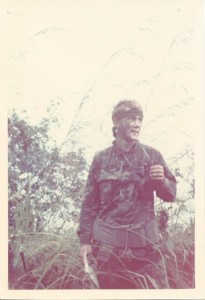 The mission of our outfit (K company, Ranger, 75th Infantry) was Long Range Reconnaissance Patrols (LRRP: pronounced lurp). We worked in four man teams that were flown by helicopter into remote areas and dropped off in the jungle for reconnaissance. After four or five days, the choppers would return to pick us up. Because subterfuge was our primary defense, we would be retrieved by the birds ASAP in the event we were exposed. We played hide and seek well.
The mission of our outfit (K company, Ranger, 75th Infantry) was Long Range Reconnaissance Patrols (LRRP: pronounced lurp). We worked in four man teams that were flown by helicopter into remote areas and dropped off in the jungle for reconnaissance. After four or five days, the choppers would return to pick us up. Because subterfuge was our primary defense, we would be retrieved by the birds ASAP in the event we were exposed. We played hide and seek well.
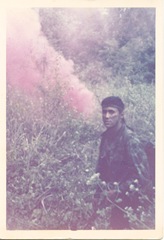 For 5-6 months, I worked with the same three teammates—Mark Estopare, Billy Powers, and Gary Heald—operating as R-18 (Ranger 18 or Romeo 18 according to the phonetic alphabet). We were stationed in the central Highlands of Viet Nam, in conjunction with the 4th Infantry Division, and lived in base camps near An Khe, Pleiku, and Ban Me Thuot when we weren’t in the field.
For 5-6 months, I worked with the same three teammates—Mark Estopare, Billy Powers, and Gary Heald—operating as R-18 (Ranger 18 or Romeo 18 according to the phonetic alphabet). We were stationed in the central Highlands of Viet Nam, in conjunction with the 4th Infantry Division, and lived in base camps near An Khe, Pleiku, and Ban Me Thuot when we weren’t in the field.
Mark was barely 18 and from St. Louis. I haven’t seen him since Viet Nam, but we have spoken by phone a couple of times. I understand he has had a hard time of it with PTSD.
 Billy wasn’t much older and spoke with a Texas twang. I saw Billy in San Antonio at a Ranger reunion about three years ago, and the drawl was still there as well as his buoyant humor. He suffered a back injury from a work accident a few years earlier and was receiving worker’s comp. Still in Texas with grown kids.
Billy wasn’t much older and spoke with a Texas twang. I saw Billy in San Antonio at a Ranger reunion about three years ago, and the drawl was still there as well as his buoyant humor. He suffered a back injury from a work accident a few years earlier and was receiving worker’s comp. Still in Texas with grown kids.
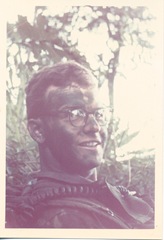 Gary was the oldest at 23 (I was 21). Gary flew to Minnesota to be one of the groomsmen in my wedding in 1971, I had dinner with him in Los Angeles in 1987, and he was at the same Ranger reunion in San Antonio three years ago. We stay in touch via email. Gary grew up in Oklahoma but settled in California. Remarried with adult kids.
Gary was the oldest at 23 (I was 21). Gary flew to Minnesota to be one of the groomsmen in my wedding in 1971, I had dinner with him in Los Angeles in 1987, and he was at the same Ranger reunion in San Antonio three years ago. We stay in touch via email. Gary grew up in Oklahoma but settled in California. Remarried with adult kids.
We have animal stories: a rat perched on my shoulder as I pulled midnight guard duty; a tiger silhouetted against the moon as he sauntered along the edge of our night location; and monkeys passing by in the treetops, sounding like the whole God damned North Viet Namese army crashing down on us as we hunkered to the ground, butt muscles tight, and lungs unbreathing. We have drinking stories, and drugs, too. Filipino bands singing rock and roll; movie stars and football players snapping photos of us and we of them; the Beatles partying late on the Panasonic bought at the PX; poker players with military script; and personal AO’s. We have stories of searing sun and monsoon rains. Ponchos. Poncho liners. Prick 25s. Rucksacks. C4. Fragmentary grenades. Smoke grenades. White phosphorous grenades. Later, Bronze stars with V devices. We have flying stories of door gunners and cobra gunships and hot LZs. We have mountain stories, river stories, hooches under triple-canopy jungle stories, and stories of elephant grass much taller than our head. In our stories, there are many faces with names long forgotten. We have shooting stories that come to us in the pale light between wake and sleep, and non-shooting stories, too, of young men from the north passing unknowing in front of our claymores and M16 muzzles, smokin’ and ajokin’ down the mountain, alive still and so were we. We became fathers and grandfathers with stories; I think they did, too.
This is a repost from last Veteran’s day.
UPDATE: SINCE PENNING THIS POST, I HAVE CREATED A SEPARATE WEBSITE ENTITLED “LRRPS OF VIETNAM”, AND I HAVE ALSO PUBLISHED FIVE SHORT STORIES BASED ON MY NAM EXPERIENCE. THE SHORT STORIES, ENTITLED PROWL ARE AVAILABLE AS AN EBOOK FOR $6.99 OR PAPERBACK FOR $9.95.
I’ve started a new blog
Spirit of a Liberal will continue; however, I have started a new blog that pertains solely to my novel, writing and publishing issues, and other literary matters. Last week, I moved a lot of my prior posts about the novel and reviews of other books from Spirit of a Liberal to the new blog. Apologies to those who received a “tweet” every time I moved a post.
The new blog is entitled The Author’s Blog … from the author of A Wretched Man novel, and may be seen here. Please continue to follow Spirit of a Liberal and add The Author’s Blog to the blogs you follow.
A Wretched Man novel trailer
My publisher has created a trailer for the novel that is intended to offer visual and audio enticement. Here it is:
They’re here! A Wretched Man novel now available.
 The shipments of my novel have arrived at the distributor’s warehouse (for transshipment to retailers including Amazon), at the website fulfillment center, and my personal copies at my house. Those of you who have preordered through various media should expect to receive your books very soon. Those who have been waiting until the books are actually available, that moment has arrived.
The shipments of my novel have arrived at the distributor’s warehouse (for transshipment to retailers including Amazon), at the website fulfillment center, and my personal copies at my house. Those of you who have preordered through various media should expect to receive your books very soon. Those who have been waiting until the books are actually available, that moment has arrived.
It’s exciting and scary. They’re actually for sale. Click here to go to the ecommerce website. Locally in Northfield, they’ll be at Monkey See, Monkey Read bookstore, and I will be signing, selling, and reading this Saturday at Bethel Lutheran starting at noon.
Thanks for the support and encouragement.
A look back at the Philadelphia Eleven and Women’s Ordination
Yesterday was the thirty-fifth anniversary of the “irregular” ordination of the Philadelphia Eleven, a group of Episcopal women who broke the gender barrier and became priests. Thanks to Susan Russell who sarcastically reminds us of that earth shattering day that threatened to “Destroy Western Civilization as we Know it.”
Russell’s blog post retells the events of that day and that time, and she recalls the names of the eleven brave women. One on that list is Alla Bozarth, whose memoir is entitled Womanpriest, a Personal Odyssey.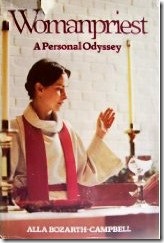
“[T]he seeds of Christian feminism were planted in my own soul,” Bozarth writes, “by my Christian urban education in the politics of racism.”
Bozarth reminds us how the torch is passed from one oppressed group seeking justice to the next, a theme that Russell also touches upon in her blog post. Russell analogizes to the LGBT breakthroughs (gay marriage, gay clergy) at the recent Episcopal General Convention.
Bozarth continues,
I [had] heard Christ calling me to lay claim on the dignity that is mine as a human being created in the image of God, female … I [had learned] to expand my vision of God, to recognize that God is more inclusive than any human idea of deity has ever been.
But then she encountered a powerful, angry man, in the person of the Dean of her seminary: “we were greeted with indignation gradually blooming into ripened rage.” Later, she was frustrated by the failure of resolutions to authorize the ordination of women at the General Conventions of 1970 and 1973, even though majorities at both assemblies voted in favor of the resolutions, but procedures required a supra-majority.
I began to question the inconsistencies between the Church’s teaching and practice with regard to women. I perceived that the Church which had taught me to believe in my human dignity had itself denied me that dignity…
I began to understand that I was unacceptable as a woman by the very Church that had taught me to celebrate my womanhood … Eventually, anger subsided into heartache and deep loneliness. I had no thought of leaving the Church; I felt that it had already left me. The denial of my calling to the priesthood was the denial of me as a child of God.
Defying convention and The Conventions, the Philadelphia Eleven, along with a few good men, forced the issue. “What the Episcopal Church needed was a fait accompli. God was soon to provide.”
That historic day began like any other summer day in Philadelphia. It was beastly hot and humid when we met in the vesting room of the Church of the Advocate at ten in the morning. The eleven of us were vested in appropriate garb for the occasion—white albs and red stoles worn over one shoulder in diaconal style…
As we stood behind the sanctuary with the other ordinands and our priest and lay presenters, we heard spontaneous laughter and then applause coming from inside the church. The sound was our first clue that there was a mighty and joyous throng on the other side to meet us and celebrate with us.
A black man, Dr. Charles Willie, a Harvard professor, offered the sermon in ringing, soaring tones reminiscent of the finest civil rights oratory of Dr. Martin Luther King. Earlier, Dr. Willie had offered a sermon in Syracuse, in response to the failure of the Conventions to endorse women’s ordination, in which he said:
And so it is meet and right that a bishop who believes that in Christ there is neither Greek nor Jew, male nor female, ought to ordain any … person who is qualified for the Holy Orders. A bishop who, on his own authority, ordains a woman deacon to the priesthood will be vilified, and talked about, but probably not crucified. Such a bishop would be following the path of the Suffering Servant, which is the path Jesus followed. It requires both courage and humility to disobey an unjust law.
The church is in need of such a bishop today.
Not one, but three bishops answered the call, and they performed the rite of ordination on July 29, 1974. Soon thereafter, the Church officially changed its policies, and today the Presiding Bishop of the Episcopal Church is the The Most Rev. Dr. Katharine Jefferts Schori.
Bozarth later penned the following poem:
Talitha Cumi Young woman, I say to you, Arise.” – Luke 8:54
Do not send me, O God, for I am only a woman and do not know what to say.
Do not say “I am only a woman.” Rise up a New Creation and take the name
I Am.
Am I a stone that my body should be turned to bread? Am I a little one whom others should not offend? Am I not dumb and immovable and worse than dead?
You are being and motion, fire in the mountain, storm in the sea-deep, vermillion sky-gilding sun. Rise up a New Creation and take the name
I Am.
Am I a devil, a danger, a soul-dagger-drudge, a babe, a hag, a desert, a plague?
You are a woman a human a person a prophet a sister a creature an icon-breaker/re-maker a judgment a vision a life.
Rise up a New Creation and take the name
I Am.
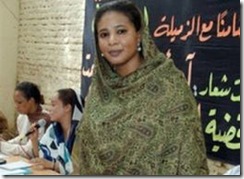 In closing, I ask all to remember the brave young Sudanese woman, Lubna Hussein, who has chosen to forsake the UN immunity offered her and to willingly stand trial for wearing trousers in public in violation of the country’s strict Islamic laws. She showed up for trial wearing the same outfit, and several of her supporters also wore pants to the hearing.
In closing, I ask all to remember the brave young Sudanese woman, Lubna Hussein, who has chosen to forsake the UN immunity offered her and to willingly stand trial for wearing trousers in public in violation of the country’s strict Islamic laws. She showed up for trial wearing the same outfit, and several of her supporters also wore pants to the hearing.
She faces forty lashes if convicted, and the verdict was postponed until next week.
Book Review: Another Incarnation
In a lengthy book review in the Sunday New York Times, Pankaj Mishra offers an indepth discussion of western cultural and religious bias against the “polytheistic muddle” of Indian religions. His review is reprinted here.
Visiting India in 1921, E. M. Forster witnessed the eight-day celebration of Lord Krishna’s birthday. This first encounter with devotional ecstasy left the Bloomsbury aesthete baffled. “There is no dignity, no taste, no form,” he complained in a letter home. Recoiling from Hindu India, Forster was relieved to enter the relatively rational world of Islam. Describing the muezzin’s call at the Taj Mahal, he wrote, “I knew at all events where I stood and what I heard; it was a land that was not merely atmosphere but had definite outlines and horizons.”
Forster, who later used his appalled fascination with India’s polytheistic muddle to superb effect in his novel “A Passage to India,” was only one in a long line of Britons who felt their notions of order and morality challenged by Indian religious and cultural practices. The British Army captain who discovered the erotic temples of Khajuraho in the early 19th century was outraged by how “extremely indecent and offensive” depictions of fornicating couples profaned a “place of worship.” Lord Macaulay thundered against the worship, still widespread in India today, of the Shiva lingam. Even Karl Marx inveighed against how man, “the sovereign of nature,” had degraded himself in India by worshipping Hanuman, the monkey god.
Repelled by such pagan blasphemies, the first British scholars of India went so far as to invent what we now call “Hinduism,” complete with a mainstream classical tradition consisting entirely of Sanskrit philosophical texts like the Bhagavad-Gita and the Upanishads. In fact, most Indians in the 18th century knew no Sanskrit, the language exclusive to Brahmins. For centuries, they remained unaware of the hymns of the four Vedas or the idealist monism of the Upanishads that the German Romantics, American Transcendentalists and other early Indophiles solemnly supposed to be the very essence of Indian civilization. (Smoking chillums and chanting “Om,” the Beats were closer to the mark.)
As Wendy Doniger, a scholar of Indian religions at the University of Chicago, explains in her staggeringly comprehensive book, the British Indologists who sought to tame India’s chaotic polytheisms had a “Protestant bias in favor of scripture.” In “privileging” Sanskrit over local languages, she writes, they created what has proved to be an enduring impression of a “unified Hinduism.” And they found keen collaborators among upper-caste Indian scholars and translators. This British-Brahmin version of Hinduism — one of the many invented traditions born around the world in the 18th and 19th centuries — has continued to find many takers among semi-Westernized Hindus suffering from an inferiority complex vis-à-vis the apparently more successful and organized religions of Christianity, Judaism and Islam.
The Hindu nationalists of today, who long for India to become a muscular international power, stand in a direct line of 19th-century Indian reform movements devoted to purifying and reviving a Hinduism perceived as having grown too fragmented and weak. These mostly upper-caste and middle-class nationalists have accelerated the modernization and homogenization of “Hinduism.”
Still, the nontextual, syncretic religious and philosophical traditions of India that escaped the attention of British scholars flourish even today. Popular devotional cults, shrines, festivals, rites and legends that vary across India still form the worldview of a majority of Indians. Goddesses, as Doniger writes, “continue to evolve.” Bollywood produced the most popular one of my North Indian childhood: Santoshi Mata, who seemed to fulfill the materialistic wishes of newly urbanized Hindus. Far from being a slave to mindless superstition, popular religious legend conveys a darkly ambiguous view of human action. Revered as heroes in one region, the characters of the great epics “Ramayana” and “Mahabharata” can be regarded as villains in another. Demons and gods are dialectically interrelated in a complex cosmic order that would make little sense to the theologians of the so-called war on terror.
Doniger sets herself the ambitious task of writing “a narrative alternative to the one constituted by the most famous texts in Sanskrit.” As she puts it, “It’s not all about Brahmins, Sanskrit, the Gita.” It’s also not about perfidious Muslims who destroyed innumerable Hindu temples and forcibly converted millions of Indians to Islam. Doniger, who cannot but be aware of the political historiography of Hindu nationalists, the most powerful interpreters of Indian religions in both India and abroad today, also wishes to provide an “alternative to the narrative of Hindu history that they tell.”
She writes at length about the devotional “bhakti” tradition, an ecstatic and radically egalitarian form of Hindu religiosity which, though possessing royal and literary lineage, was “also a folk and oral phenomenon,” accommodating women, low-caste men and illiterates. She explores, contra Marx, the role of monkeys as the “human unconscious” in the “Ramayana,” the bible of muscular Hinduism, while casting a sympathetic eye on its chief ogre, Ravana. And she examines the mythology and ritual of Tantra, the most misunderstood of Indian traditions.
She doesn’t neglect high-table Hinduism. Her chapter on violence in the “Mahabharata” is particularly insightful, highlighting the tragic aspects of the great epic, and unraveling, in the process, the hoary cliché of Hindus as doctrinally pacifist. Both “dharma” and “karma” get their due. Those who tilt at organized religions today on behalf of a residual Enlightenment rationalism may be startled to learn that atheism and agnosticism have long traditions in Indian religions and philosophies.
Though the potted biographies of Mughal emperors seem superfluous in a long book, Doniger’s chapter on the centuries of Muslim rule over India helps dilute the lurid mythology of Hindu nationalists. Motivated by realpolitik rather than religious fundamentalism, the Mughals destroyed temples; they also built and patronized them. Not only is there “no evidence of massive coercive conversion” to Islam, but also so much of what we know as popular Hinduism — the currently popular devotional cults of Rama and Krishna, the network of pilgrimages, ashrams and sects — acquired its distinctive form during Mughal rule.
Doniger’s winsomely eclectic range of reference — she enlists Philip Roth’s novel “I Married a Communist” for a description of the Hindu renunciant’s psychology — begins to seem too determinedly eccentric when she discusses Rudyard Kipling, a figure with no discernible influence on Indian religions, with greater interpretative vigor than she does Mohandas K. Gandhi, the most creative of modern devout Hindus. More puzzlingly, Doniger has little to say about the forms Indian cultures have assumed in Bali, Mauritius, Trinidad and Fiji, even as she describes at length the Internet-enabled liturgies of Hindus in America.
Yet it is impossible not to admire a book that strides so intrepidly into a polemical arena almost as treacherous as Israel-Arab relations. During a lecture in London in 2003, Doniger escaped being hit by an egg thrown by a Hindu nationalist apparently angry at the “sexual thrust” of her interpretation of the “sacred” “Ramayana.” This book will no doubt further expose her to the fury of the modern-day Indian heirs of the British imperialists who invented “Hinduism.” Happily, it will also serve as a salutary antidote to the fanatics who perceive — correctly — the fluid existential identities and commodious metaphysic of practiced Indian religions as a threat to their project of a culturally homogenous and militant nation-state.
Book Review: The Chronicles of Narnia, by C.S. Lewis
Here, we will mention an author and his entire body of work since his importance ranges across all his novels and other writings. My introduction to Lewis was in my freshman English class at Dartmouth, under the esteemed conservative, Professor Jeffrey Hart, where Perelandra (part of the Space Trilogy) was assigned reading. The extra terrestials (eldila) in this fantasy novel bore a remarkable affinity to angels.
C.S. Lewis – Clive Staples Lewis (1898 – 1963) – was a leading figure of the English faculty at Oxford University and a close friend of J. R. R. Tolkien, the author of The Lord of the Rings. Although an academic himself, Lewis was critical of the historical approach to evaluating Scripture prevalent in the universities of the mid twentieth century, and he became a Christian apologist in essays and novels.
His most famous apologia, Mere Christianity, was a compilation of BBC radio essays broadcast during the early 1940’s.
Out of the Silent Planet (1938) was the first of The Space Trilogy soon followed by Perelandra (1943) and then That Hideous Strength (1945). Although space travel provides the setting, the books have little to do with the science of planetary exploration, which is merely a mythological framework for his treatment of Christian themes with a heavy dose of Lewis’ views on Christian theology. The storyline is apocalyptic, with battles of good vs evil, fallen angels, and a final decisive struggle. It has similarities with Tolkien’s fantasy world and themes of cataclysmic battle.
The Screwtape Letters (1942) is a fictional account of a series of letters from a senior demon, Screwtape, to his nephew, Wormwood. The premise of the letters is the temptation of humankind. Set in a contrived bureaucracy of Hell, Screwtape, Wormwood, and others attempt to lead humankind astray and thus render them candidates for damnation. Along the way, Lewis offers his hard hitting, conservative views on a variety of theological and moral issues.
Written between 1949 and 1954, The Chronicles of Narnia are Lewis’ most famous works with nearly 120 million copies sold. The seven books of this children’s fantasy series have achieved classic status with multiple reprints, foreign translations, and television and movie adaptations. If William Young receives rebuke for his imagining of God as a sassy, black woman in The Shack, Lewis paved the way by treating the talking Lion Aslan as a Christ figure. These stories are reaching the current generation of children through the popular movie series underway. The recurring storyline has human children magically transported to the fantasy world of Narnia where they join Aslan in the battle of good vs evil.